When it comes to butter, everyone is familiar with it. Even if I have never seen butter, I have eaten all kinds of butter bread and butter biscuits. However, many people do not know that butter is actually a dairy product.

Butter is called cream in Taiwan and butter in Hong Kong . According to China’s national food safety standards, butter or cream corresponds to butter, and cream corresponds to cream .
The History of Butter: Edible and Usable
Speaking of which, butter is also a food with a long history. The earliest record of butter can be traced back to a piece of limestone 4,500 years ago, which shows the production process of butter in the form of pictures. In addition to being a food, butter was used in religious ceremonies in many cultures due to its rarity and purity at the time.
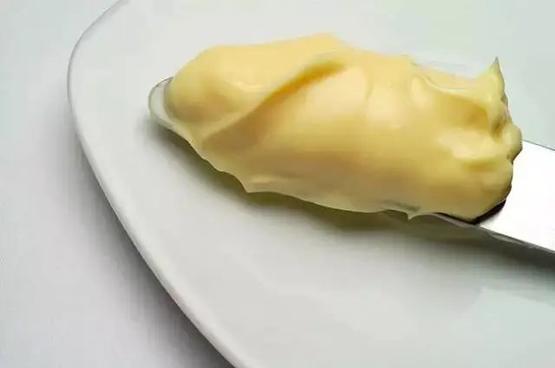
Butter has historically been used as a panacea and is widely used in every aspect of daily life by people all over the world. The ancient Greeks and Romans used butter as a “morning and evening cream” on the skin and as a “hair wax” on the hair to achieve the cosmetic effect of “oily and powdery”. The ancient Egyptians used butter as a remedy for eye infections and applied it to the skin to treat skin infections and burns. Northern Europeans believe that eating butter can prevent kidney and bladder stones. There is also an ancient custom in the United Kingdom, which is to give a jar of butter to the newlyweds to wish them more children and more happiness.
Originally in Europe, butter was considered barbarian food by the ancient Romans and ancient Greeks. Only after the fifteenth century did butter slowly take a flamboyant turn and become a symbol of wealth and luxury. This turnaround did not last long. With the development of industrial production after the Industrial Revolution, the production efficiency of butter has been improved, and the production cost has been greatly reduced. Butter, which was originally a luxury item, gradually appeared on the dining table of ordinary people.
In addition, there are many artists who use butter as a raw material to create art works today.
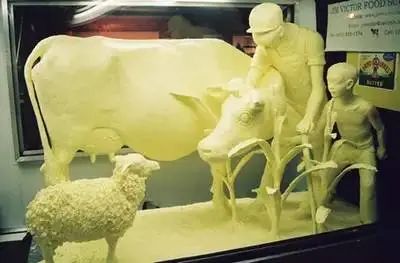
Butter Sculptures: Farm Life by Jim Victor
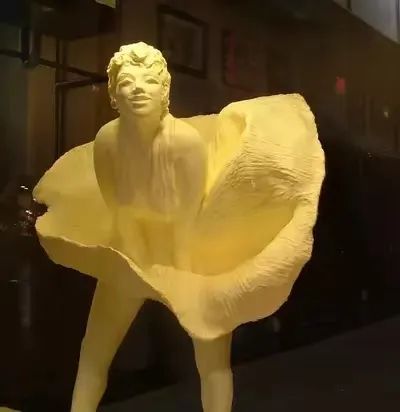
Butter Sculpture: Marilyn Monroe by Shawn Bowman
What is the relationship between cream and butter?
So how is butter produced?
Milk is an emulsion that contains around 3.6% fat. These fats are dispersed in milk in the form of small fat globules, which are very small in diameter, usually between 0.1-20 microns. Why don’t these little fat globules clump together and layer the milk? This has to talk about the composition of milk fat: more than 98% of milk fat is neutral fat mainly composed of triglycerides, and the remaining less than 2% is polar fat mainly composed of phospholipids. The innermost of these small fat globules are hydrophobic triglycerides, which are surrounded by a membrane of phospholipids and proteins. The hydrophobic side of the membrane rests on the equally hydrophobic triglycerides, while the hydrophilic side is exposed, allowing these small fat globules to exist relatively stably in the milk without clumping together.
However, although fat globules do not fuse and aggregate, they are still less dense. Therefore , the milk is placed for a long time, and the fat will slowly float to the upper layer. Using this difference in density, we can separate milk into cream and skim milk through the principle of centrifugation.
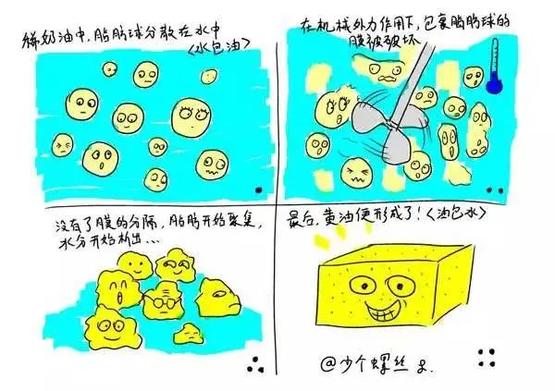
The process of turning cream into butter
Cream contains about 40% fat and about 60% water , and these fats are also dispersed in the water in the form of fat globules. Fat globules are separated by membranes on the outer surface and thus cannot aggregate from each other. The fat globules are surrounded by continuous water. So we say it’s oil-in-water.
At this time, if we apply a mechanical external force to the cream to break the membrane surrounding the fat globules, we can make the originally isolated fat globules unite. If we also maintain a lower temperature and let the fat solidify (the freezing point of milk fat is around 30 degrees Celsius), the excess water will be separated from the fat. Slowly, the small solidified fat particles stick to each other, forming a big lump. At this time, the remaining small amount of water is dispersed in the fat in the form of small droplets, the oil-in-water situation is reversed to water-in-oil, and the cream becomes butter .
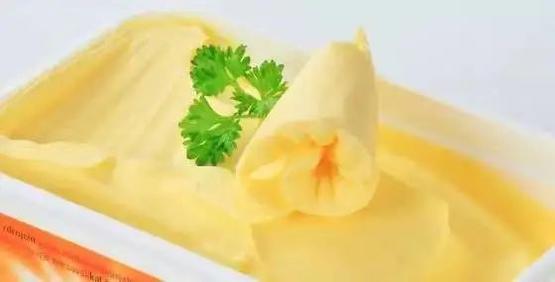
In the actual production process, the cream is usually pasteurized first . On the one hand, the microorganisms in it are eliminated to ensure uniform product quality, and on the other hand, the lipase and oxidoreductase can be inactivated, thereby limiting the Their effect on the breakdown and oxidation of milk fat. Then, the cream is also inoculated with specific lactic acid bacteria to ferment it to produce butter-specific flavor substances. This is followed by vigorous whipping of the cream to complete the inversion process from oil-in-water to water-in-oil. Finally, the lumps of unshaped butter are turned into a homogeneous butter by slow and gentle mixing . In this last step, salt can also be added to produce salted or semi-salted butter.
Typically, to produce 1 kg of butter, 20 liters of whole milk (using only the fat content) are required.
Butter is delicious, don’t be greedy
Butter is delicious, and there’s even an old French saying, “No butter, no meal.” Butter can be eaten directly on bread, used to cook other foods, and used to make pastries and cookies. More than 80% of butter is fat, and contains less than 16% of water, and the rest is residual protein, sugar, minerals and vitamins. Butter is high in calories , with 100 grams of butter containing 3136 kJ (750 kcal), which is much higher than chocolate (100 grams of dark chocolate contains about 2200 kJ). What you may not know is that in addition to providing more calories for the human body, butter is also rich in fat-soluble vitamins (vitamins A, D, E, K), especially vitamin A. Eating 10 grams of butter can provide 8% of the human body. Daily requirement of vitamin A.
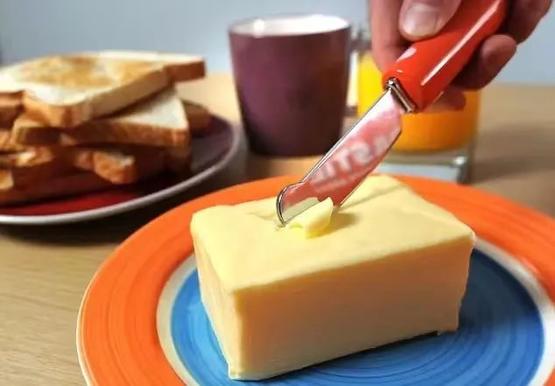
However, butter is also high in cholesterol , with 240-280 mg of cholesterol per 100 grams, so it is identified as one of the foods that can cause cardiovascular disease and other health problems. Therefore, it is better for people with high blood lipids to eat less butter , but for people with normal lipid metabolism, moderate consumption of butter will not cause any damage to the body. Since the vitamins in butter are easily destroyed at high temperatures, it is best to smear the butter directly on the bread and eat it raw. Although butter is also a dairy product, it contains only a small amount of lactose, so even people who are lactose intolerant can eat butter without causing discomfort.
So, if you eat a little bit of butter every day, won’t you buy a piece and it will go bad? There is no need to worry about this. The main component of butter is fat, and microorganisms cannot survive and reproduce on it . The only thing to pay attention to is the oxidation and hydrolysis of fat. If the storage temperature is too high or the packaging is not strict, the oxidation or hydrolysis of fatty acids may produce some volatilization. Sexual ketones and aldehydes, which give butter an unpleasant odor. Therefore, pay attention to how much you eat and how much you unpack each time you eat, and remember to wrap it up and put it back in the refrigerator afterward. In addition, if you buy too much, you can freeze the butter. When you need to eat it, remember to put it back in the refrigerator to thaw five or six hours in advance.
an AI
butter = butter = butter in Taiwan = butter in Hong Kong;
cream = “cream” = cream;
The milk is centrifuged to become cream and skim milk; the cream is then whipped to become butter.
The “99%” in the title was made up by me.
Author: few screws
This article is from Nutshell and may not be reproduced without authorization.
If necessary, please contact [email protected]

This article is reproduced from: http://www.guokr.com/article/461322/
This site is for inclusion only, and the copyright belongs to the original author.